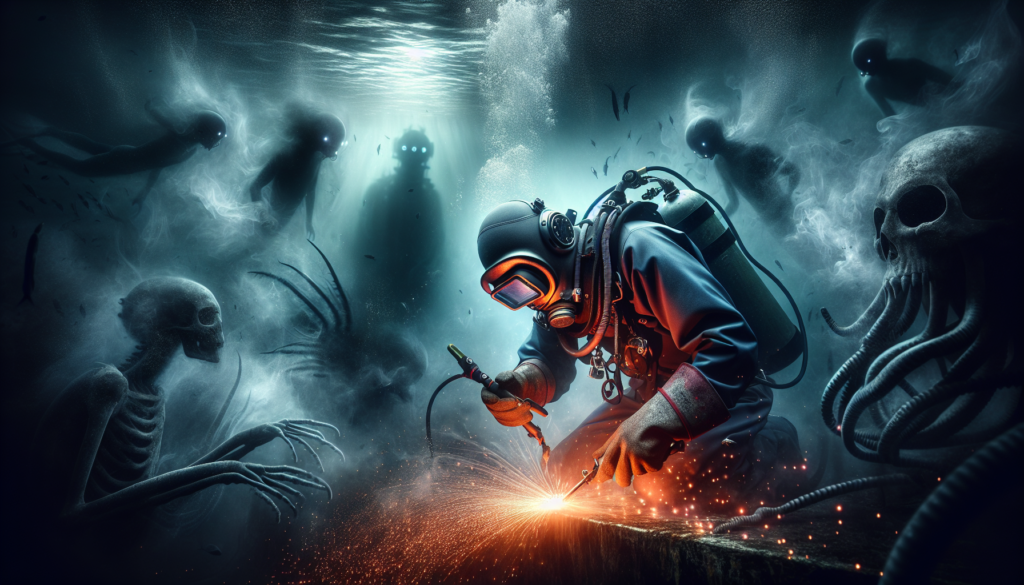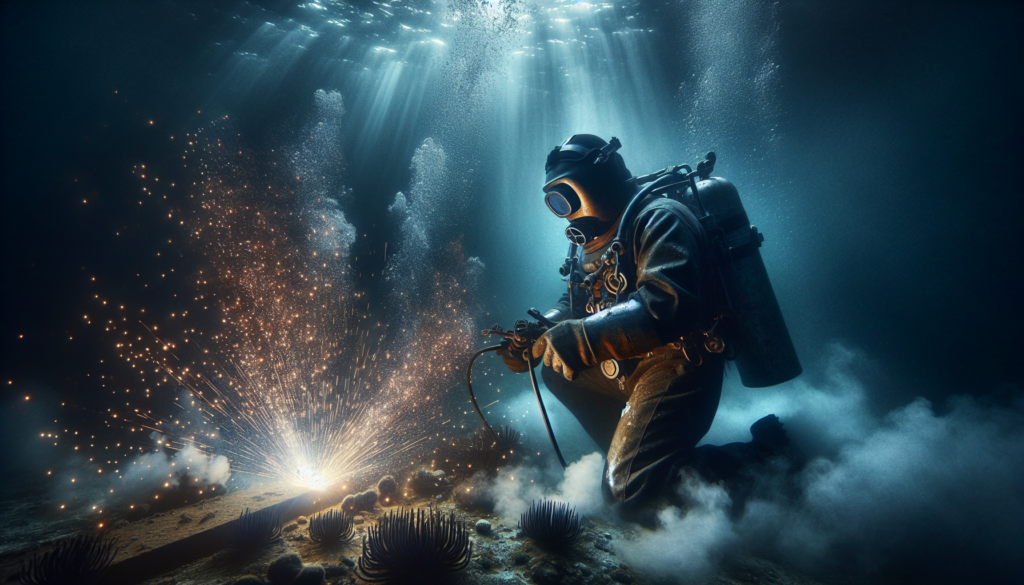Imagine being immersed in the depths of the ocean, surrounded by darkness and silence, with only your welding torch illuminating the vast underwater world. It may seem like an intriguing adventure, but what lies beneath the surface is a job filled with peril. Underwater welding, a fascinating profession that melds skill and risk, holds its own dangers that make it one of the most treacherous occupations in the world. From extreme water pressure to electric shocks, this article uncovers the reasons why underwater welding is so perilous and the measures taken to keep these brave individuals safe.
Factors Contributing to the Danger of Underwater Welding
Challenging Work Environment
Underwater welding is considered dangerous due to the challenging work environment it presents. Working under the water brings a whole set of complications that are not encountered in traditional welding. The darkness, limited visibility, and limited maneuverability underwater create a higher risk for accidents and misjudgments. The added difficulty of working in confined spaces, often with limited access and poor lighting, further increases the danger of underwater welding projects.
Limited Visibility
One of the key factors contributing to the danger of underwater welding is limited visibility. The water’s natural opacity, along with suspended particles and sediment, reduces visibility, making it difficult for welders to see their work clearly. This limited visibility can lead to errors in weld placement, inadequate penetration, or even welding on the wrong components. This compromised vision increases the chances of accidents and decreases the overall quality of the weld.
High Pressure and Water Depth
Underwater welding is performed at significant depths, subjecting welders to high pressure and water depth. As divers descend deeper into the water, the pressure increases significantly, creating a hostile environment for human bodies. The physiological effects of high pressure can cause various health issues, including decompression sickness, burst lung syndrome, and nitrogen narcosis. Furthermore, working at great depths increases the risks of equipment failure and makes emergency evacuations more challenging.
Hazardous Gases and Contaminants
Another major concern in underwater welding is the presence of hazardous gases and contaminants in the water. Welding underwater produces a variety of gases like hydrogen, carbon monoxide, and nitrogen oxide, which are highly toxic if inhaled in large amounts. These gases can quickly accumulate around the welder, leading to asphyxiation and severe health complications. Additionally, the water itself can contain contaminants such as oil, chemicals, and biological pollutants, further exacerbating the risks to the welders’ health.
Electrocution Risks
Electrocution is a significant risk in underwater welding, given the presence of both electricity and water. Welders utilize electric currents to generate the heat necessary for welding, but the combination of electricity and water can be lethal. Poorly insulated equipment or improper grounding can result in electric shocks to the welder. These shocks can lead to severe injuries, including internal burns, muscle contractions, paralysis, and even death. Proper safety measures and adherence to strict protocols are necessary to mitigate the risks of electrocution in underwater welding.
Physical Hazards Associated with Underwater Welding
Drowning and Hypothermia
Two of the most imminent physical hazards in underwater welding are drowning and hypothermia. Welders work surrounded by water, and any equipment or procedural failures can result in a breach of their protective barrier, leading to drowning. Additionally, the prolonged exposure to cold water can cause rapid heat loss from the body, leading to hypothermia. Cold water reduces the welder’s ability to focus and can impair motor skills, increasing the likelihood of accidents and decreasing overall effectiveness.
Explosions and Fires
Explosions and fires are critical risks associated with underwater welding. The presence of combustible gases and the high heat generated during the welding process can trigger explosions or fires if proper safety precautions are not taken. A small spark or contact with a flammable substance can lead to catastrophic consequences, endangering the lives of the welders and potentially damaging the surrounding environment. Adequate fire prevention measures, such as the use of non-flammable gases and rigorous inspection protocols, are crucial in minimizing the risk of explosions and fires.
Decompression Sickness
Decompression sickness, also known as “the bends,” is a potentially life-threatening hazard faced by underwater welders. The condition occurs when a diver ascends too quickly, causing dissolved gases, specifically nitrogen, to form bubbles in their tissues and bloodstream. The symptoms vary from joint and muscle pain to neurological issues and, in severe cases, can result in paralysis or even death. Proper decompression procedures, such as staged ascents and mandatory decompression stops, are essential to mitigate the risks of decompression sickness in underwater welding.
Musculoskeletal Disorders
Underwater welding involves working in physically demanding conditions for extended durations, placing a strain on the welder’s musculoskeletal system. The awkward body postures, repetitive movements, and heavy equipment can contribute to various musculoskeletal disorders, including back pain, joint injuries, and muscle strains. These conditions not only cause discomfort for the welder but also impact their ability to perform welding accurately and safely. Regular breaks, ergonomic equipment design, and exercise regimens can help prevent or mitigate the occurrence of musculoskeletal disorders in underwater welders.

Equipment and Procedure-Related Risks in Underwater Welding
Electrical Hazards
Electrical hazards are a significant concern in underwater welding due to the presence of electricity in close proximity to water. Faulty equipment, damaged insulation, or improper grounding can lead to electric shocks that are potentially life-threatening to the welder. Additionally, the occurrence of electric arcing underwater can pose fire risks and further increase the danger to the welder. Regular inspection and maintenance of equipment, along with proper grounding techniques, are vital to minimize electrical hazards in underwater welding.
Equipment Failure
The failure of equipment used in underwater welding can have severe consequences for the safety of the welder. Equipment failure may include issues with breathing systems, diving suits, welding machines, and underwater tools. Malfunctioning equipment can lead to accidents, loss of communication, or even loss of consciousness while underwater. Regular inspections and maintenance of all equipment, as well as redundancy measures such as backup breathing systems, are crucial in preventing equipment-related risks in underwater welding.
Breathing Gas Supply Problems
Maintaining an adequate supply of breathing gas is essential for the safety and well-being of underwater welders. Any interruption or failure in the breathing gas supply can result in asphyxiation, loss of consciousness, and drowning. Issues like regulator malfunctions, air line entanglement, or depletion of the gas supply can rapidly escalate into life-threatening situations. Thorough equipment checks, adherence to predetermined dive plans, and effective communication with support teams are necessary to prevent breathing gas supply problems during underwater welding operations.
Divers’ Inadequate Training and Certification
Inadequate training and certification of divers in underwater welding can significantly contribute to the overall risks and dangers associated with the profession. Lack of proper training leads to insufficient knowledge of safety procedures, poor understanding of underwater welding techniques, and inadequate awareness of potential hazards. Divers who are not adequately trained and certified are more prone to errors and are less prepared to handle emergency situations effectively. Therefore, it is essential for all underwater welders to undergo comprehensive training and obtain the necessary certifications to ensure their safety and the safety of the entire team.
Safety Measures and Prevention Strategies in Underwater Welding
Proper Training and Certification
To mitigate the risks associated with underwater welding, proper training and certification are paramount. Comprehensive training programs should cover topics such as welding techniques, safety procedures, emergency response protocols, and understanding the equipment used underwater. Certification ensures that the welders have met the required qualifications and possess the necessary knowledge and skills to perform their tasks safely. Ongoing training and recertification programs also help keep the welders up-to-date with the latest developments in underwater welding safety.
Well-Maintained Equipment
Regular inspection, maintenance, and repair of equipment are vital in ensuring the safety of underwater welders. Implementing a strict maintenance schedule guarantees that all equipment is in optimal working condition, minimizing the risks of equipment failure. Equipment must be inspected for any damages or defects before every use, and any problems should be resolved promptly. By prioritizing the maintenance of the welding equipment, the likelihood of accidents caused by faulty gear can be significantly reduced.
Effective Communication and Joint Planning
Clear and effective communication between all members of the welding team is crucial in enhancing safety during underwater welding operations. Establishing effective communication channels ensures that divers can convey important information and report any hazards or issues promptly. Joint planning sessions allow the team to collectively identify potential risks, develop strategies to mitigate them, and ensure that everyone is aware of their roles and responsibilities. By promoting open and transparent communication, the chances of accidents or mistakes can be minimized.
Pre-dive Safety Briefings
Conducting pre-dive safety briefings is an essential step in ensuring the safety of underwater welders. These briefings provide an opportunity to review the dive plan, highlight potential risks, discuss emergency procedures, and reinforce safety protocols. All team members should participate in the briefing and have a clear understanding of the objectives, hazards, and emergency response plans for the operation. Pre-dive safety briefings help focus the team’s attention on safety and ensure that everyone is well-prepared for the upcoming task.

Conclusion
Underwater welding is undeniably a dangerous profession due to various factors and hazards. The challenging work environment, physical risks, equipment-related dangers, and the potential for procedure-related accidents make underwater welding a high-risk occupation. However, by implementing appropriate safety measures and prevention strategies, the risks associated with underwater welding can be effectively minimized. Proper training, well-maintained equipment, effective communication, and pre-dive safety briefings are all crucial components in ensuring the safety of underwater welders. By prioritizing safety and continuously improving the industry’s safety practices, we can strive to create a safer environment for those working in underwater welding.
